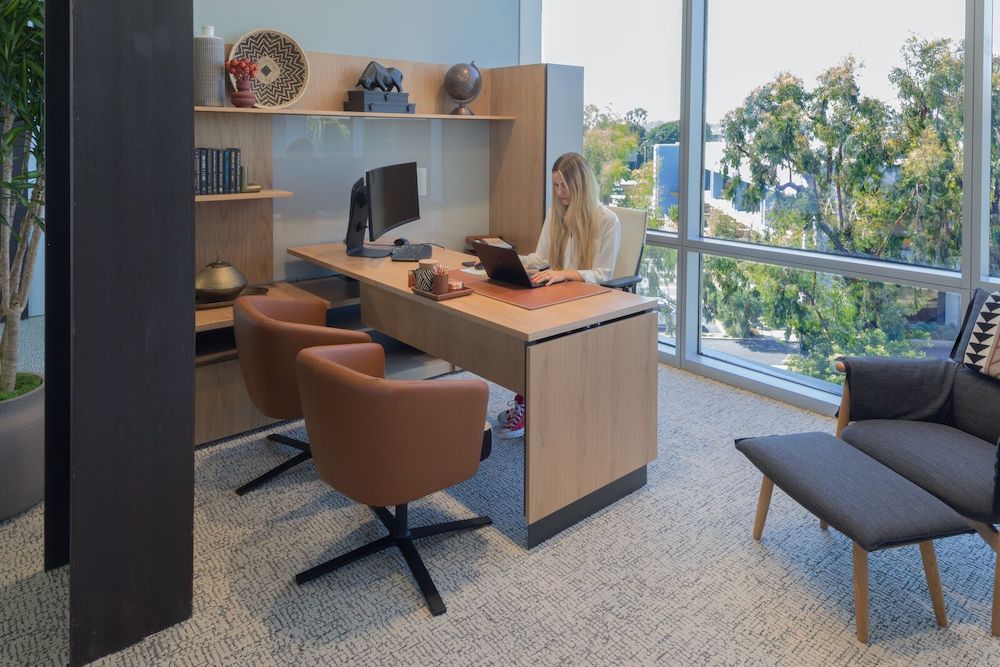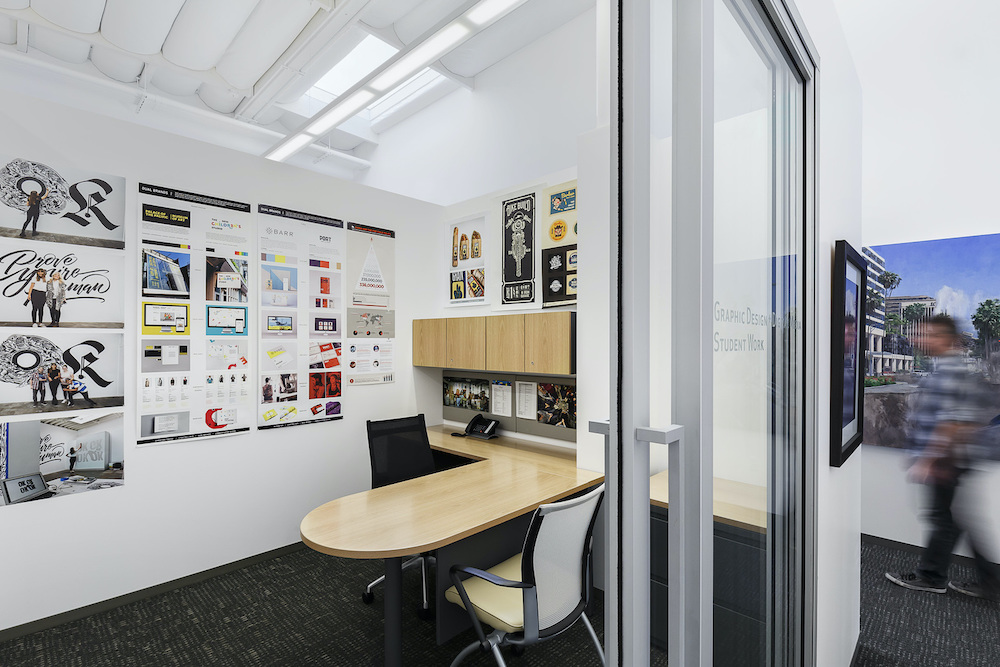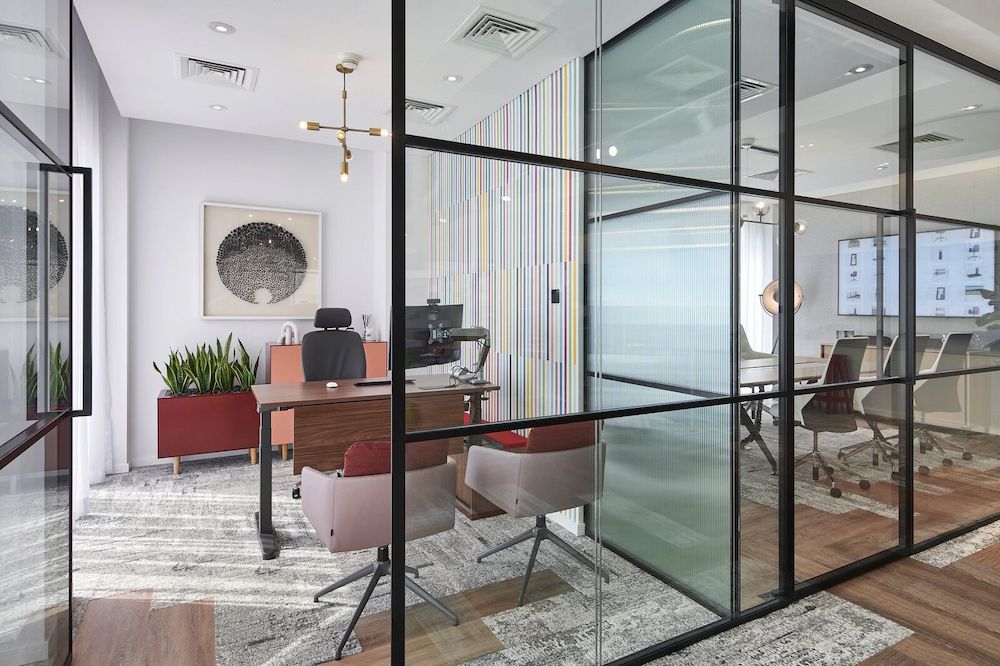Private offices are making a comeback, says Teresa Rodriguez of LPA Design Studios and Amber Jones of Tangram Interiors. But these are not your parents’ offices. Personal spaces can play a key role in a flexible, collaborative workplace.
The private office is having a moment.
As office markets adjust to the new normal, more and more clients are asking about private offices, which had essentially disappeared from many workplaces over the past few years.
Initially, this was a response to COVID. People wanted to have their own space where they can go in, shut the door, and feel a level of comfort and security, as well as privacy. In the post-pandemic paradigm, private offices are now seen by some companies as an incentive for leadership to return to the workplace, an important step in bringing employees back into the office.

While the traditional office model has held tried and true for professional services clients such as law firms and banking clients, other sectors are re-evaluating their needs and finding ways to incentivize the return to the office. Private offices are sometimes the answer. Recent research by furniture maker Steelcase found that the presence of leadership is one of the primary amenities drawing people back into the office – employees want that mentorship and guidance. And they want personalized space, where they can display family photos and personal effects like they do at home.
But our discussions around private offices these days are often more about the company’s broader mission. Executive leadership space may be important, but it should be evaluated in the context of the company’s brand and culture – private space can play a larger role in an inclusive, flexible workplace that serves many roles.

Private offices don’t have to be spaces designated for one person, forever. They can be created with flexible materials and furniture to serve multiple uses and integrate into a culture of mentorship and collaboration. While they address current needs, they can be designed to change as companies evolve and grow.
Every workplace is different, but a few core strategies can make private office space an important part of the next generation workplace.
Building a Central Core
The return of the private office doesn’t necessarily imply the return of corner offices. Companies understand the need for leadership to be accessible and approachable for mentorship opportunities and the sharing of knowledge, experience and expertise with the younger employees.

Moving private offices to a central core not only allows for easy access and visibility to leadership, but also maximizes access to natural light and views. These private spaces can also serve as huddle rooms and quiet spaces for all employees and their central location will provide ease of access when a last-minute brainstorm session or call arises.
Additionally, moving private spaces into the center core provides more mobility throughout the growth of the organization. In programming the expansion of a recent client, the relocation of perimeter offices to the central core was key and we designed the offices in a common module, allowing the client to easily change the use, if needed. Those assigned a dedicated office were expected to be in the office 85% of the time in a hybrid work model, which allowed for most team members to work three days a week in the office, and two days a week remotely.
Designing for Flexibility
In today’s workplace, every element should serve multiple purposes. If the private office isn’t reserved for a single employee, it can be used for various purposes throughout the day, including one-on-one meetings or heads down work.
Now, you may be asking, what if we don’t need the private office space in five years? We then ask, could you use more small collaborative space? An alternate space for a mother’s room or meditation space? We can always repurpose it.

Through furnishings, setup, and layout, these private spaces can become even more flexible and adaptable to different needs – now and far into the future. Offices don’t have to be built with the permanence of metal stud framing and drywall – instead, demountable designs can be reconfigured and enclosed should the need arise.
Furnishing choices can also support different strategies. Locally, “work walls” are becoming more popular. Instead of an L-shaped desk, a single-wall with a height adjustable desk and shelves create flexibility and a smaller footprint.
Creating Neighborhoods
The workplace is most successful when it becomes a collection of environments designed to meet the greater needs of the staff and company. Every employee needs the option to change environments as dictated by their schedule and their daily needs/desires – equity and inclusion should be at the forefront of any workspace planning discussion.

Private offices need to be included in the neighborhood conversation, serving as solace for someone who needs quiet or a space of connection for one-on-one mentorship. Instead of discussing how to bring leadership out of their office, perhaps we can explore how to create a private office that invites connection and conversation – or on the flip side, how surrounding neighborhoods invite engagement beyond the office walls. Whether inside or outside of a private office, it is imperative that every employee feels comfortable to utilize and interact with any colleague or environment, establishing workplace value across generations.
Technology Upgrades
A large missing factor is technology. Designs need to incorporate technology from the start, not as an afterthought. Additionally, it needs to be consistent and easily accessible throughout the entire workplace, promoting mobility and space utilization beyond the private office.

Instead of technology only being found in private offices, it should be ubiquitous to promote equity and the idea that work can happen anywhere. And it needs to be easy to use. One of the biggest challenges we hear from our clients is that teams are in the office, but still collaborating via Zoom because they have trouble utilizing the technology in their collaborative spaces.
If we’ve learned anything from recent events, it is that five years from now, everything we know about the workplace could be different. Private offices could serve an important role now, but the way we utilize them is going to continue to evolve. We need to design our workspaces with the ability to grow and adapt down the road and create spaces that create different types of value for companies.


